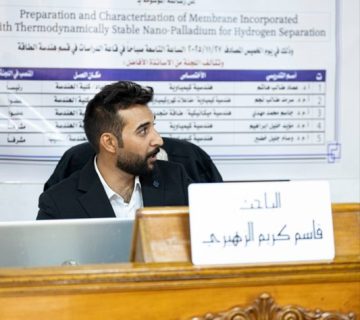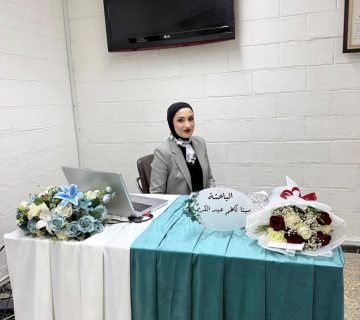The College of Engineering at University of Baghdad held a public debate of the MSc student (Qassim Mohammed Sayed) in the Department of Petroleum Engineering about her thesis titled (Laboratory Investigation of Foam Cement Performance with LV-CMC for Weak and Depleted Zones) on Wednesday (4th of March, 2024) in the Graduate Studies Hall of the Department of Petroleum Engineering.
The examining committee consisted of the following:
1- Asst. Prof. Dr. Mohammed Abdul-Ameer Al-Humairi (Chairman)
2- Asst. Prof. Dr. Omer Falih Hassan (Member)
3- Asst. Prof. Dr. Farqad Ali Hadi (Member)
4- Asst. Prof. Dr. Hassan Abdul-Hadi Abdul-Hussein (Member and Supervisor)
The thesis is summarized as follows:
Oil well cementing operations are crucial for completion and preserving the well’s productive life. Many depleted, weak, and permeable drilled formations in the Iraqi oil fields may exposed lost circulation problem and fallback the cement column, particularly when using high-density cement slurry. This leads to the cement job failure and also damages the producing layers. Because of that most companies used several types of lightweight cement for cementing these formations to avoid the previous problems
This thesis presents an experimental attempt to design a new type of lightweight cement model, namely foamed cement. In this work, a high-sulfate-resistant class G cement and two chemicals, which are a foaming agent used to form a foam system and low-viscosity carboxymethyl cellulose (CMC-LV) as a stabilizer to provide high stability of the foam system, were used in addition to air or nitrogen gas. A multi-blade blender was manufactured according to the RP10B-4 for preparing a wide range of densities of foamed cement slurry of 1.6, 1.4, 1.2, 1.0, and 0.8 g/cc. The investigated properties of base and foamed cement were the cement density, stability, free water, thickening time, porosity, permeability, compressive strength, and rheological properties. A thickening time test was also investigated for the base slurry at 52 °C and 5160 psi while compressive strength tests were conducted with three curing times (24, 48, and 72 hr.) and three temperatures (38, 60, and 75 °C). The results are then compared the results with some lightweight types. Four rheological models were applied to the base and foam cement slurry, which are Bingham plastic, Power Law, Herschel Bulkley, and Casson models. An economical comparison between the formulated foam cement with other types was made. All tests were conducted in the laboratories of Missan Oil Company and Basra Oil Company according to API procedures.
The experimental results showed that the foaming agent and CMC-LV have the optimal concentrations of 2 and 0.12% respectively (by weight of cement), and behave like retarders. The addition of foam enhances stability and prevents the presence of free water; increasing the foam volume decreases the cement density while simultaneously increasing its porosity and permeability. The permeability value can be considered acceptable of 1.18 md when the foam volumetric percentage is 36 or less compared to tests of lightweight cement applied in the fields. The compressive strength decreases as the density decreases, but it increases with higher temperatures and longer curing times. The formulated foamed cement exhibited lower permeability (1:1680) and higher compressive strength with a difference greater than 100 psi when compared to other types of lightweight cement at the same density. The Herschel Bulkley rheological model gave a lower absolute average percent error (EAAP) of about 6%, followed in decreasing order by the Casson model of about 9%. Moreover, the cost of lightweight cement was several times than the price of the formulated foam cement.








